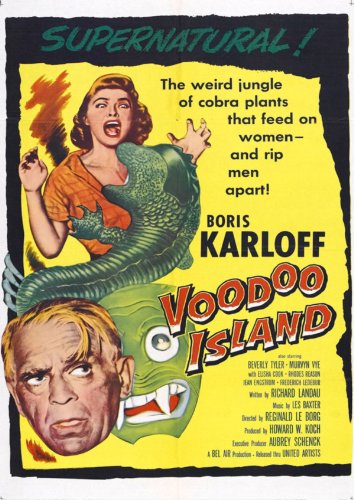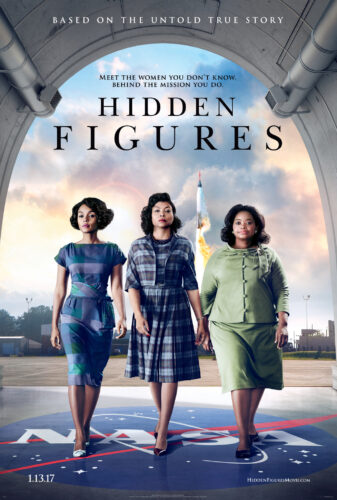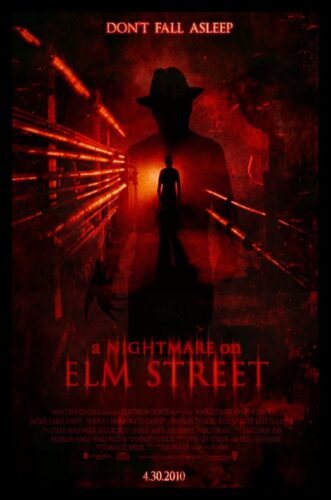 Voodoo Island (1957) – A wealthy developer owns an island which would make a great resort, except the survey team he sent disappeared, and the only one who made it back alive is catatonic. He turns to professional debunker Boris Karloff, who smirks as he puts together a team to go poke holes in any “voodoo” rumors.
Voodoo Island (1957) – A wealthy developer owns an island which would make a great resort, except the survey team he sent disappeared, and the only one who made it back alive is catatonic. He turns to professional debunker Boris Karloff, who smirks as he puts together a team to go poke holes in any “voodoo” rumors.
The question which will haunt me to the end my my days: Was this simply a poor first-draft screenplay, or was there NO screenplay, and they just made it up as they went along? Karloff gamely delivers his ostentatious mansplaining dialogue as a true professional should, but you have to imagine he was approaching Lon Chaney Jr. levels of inebriation every time he was off-camera. Thrill to the plot threads that wander off and are never heard from again! Shudder at the lesbian subtext! Gape at the German actor playing the head of the “native” population, complete with his German accent! Scream as carnivorous “plants” made from inner tubes “devour” an actress who is clearly holding them against her body! Shake your head in commiseration as the story pretty much stops when everyone involved in making it ended up just as bored as the viewers!
 Hidden Figures (2016) – There’s always the trepidation of watching a racially charged movie made in the last decade: “Is the whole point of this gonna be making white people feel bad?” I’m happy to note that that is not the point of the movie; despite the fact that anachronisms and historical inaccuracies abound (it’s “based on,” not a documentary), the racial animus is not amped up just for pathos value. Instead, it’s a movie about actual characters, both black and white, and not a one of them is assumed to be virtuous or despicable because of skin color.
Hidden Figures (2016) – There’s always the trepidation of watching a racially charged movie made in the last decade: “Is the whole point of this gonna be making white people feel bad?” I’m happy to note that that is not the point of the movie; despite the fact that anachronisms and historical inaccuracies abound (it’s “based on,” not a documentary), the racial animus is not amped up just for pathos value. Instead, it’s a movie about actual characters, both black and white, and not a one of them is assumed to be virtuous or despicable because of skin color.
If I have a complaint about the movie, it’s a technical one: CGI is used to fill in several of the rocket launches etc., and it’s just not ready for prime time. It’s especially jarring when it’s juxtaposed with actual grainy 16-mm news footage. Given that seamless CG is a common feature even on TV shows that aren’t meant to be seen on the big screen, the disappointing rendering here isn’t really excusable.
 A Nightmare on Elm Street (2010) – This would have been a perfectly serviceable remake of the 1984 original, if that original hadn’t been followed by a franchise of seven sequels ands semi-sequels which turned child-murderer Fred Krueger into a loveable scamp of an anti-hero. As it was, by walking a line between retaining and revamping features of the original (keep the sweater?), this movie guaranteed that nobody would like it: the people who hated the original obviously wouldn’t sign up for more dream killings, and diehard devotees of the original and its sequels would hate a Freddy divorced from Robert Englund’s portrayal. Predictably, this reboot garnered no sequels of its own.
A Nightmare on Elm Street (2010) – This would have been a perfectly serviceable remake of the 1984 original, if that original hadn’t been followed by a franchise of seven sequels ands semi-sequels which turned child-murderer Fred Krueger into a loveable scamp of an anti-hero. As it was, by walking a line between retaining and revamping features of the original (keep the sweater?), this movie guaranteed that nobody would like it: the people who hated the original obviously wouldn’t sign up for more dream killings, and diehard devotees of the original and its sequels would hate a Freddy divorced from Robert Englund’s portrayal. Predictably, this reboot garnered no sequels of its own.
Which is a shame, because the filmmakers found a way to amp up the evil of Freddy, making him a clear child molester rather than murderer (that’s ickier, somehow), and having him target the teens not just because their parents had killed him, but because those kids had been his actual victims a decade before. Of course, to let the teen protagonists discover the facts behind their nightmares, the plot has to rely on repressed memories for every single one of them; I wonder how the movie would have been different if they had known from the beginning who “Freddy” was, but couldn’t get the adults to look past their obvious trauma to the reality of the dream killings.
This movie brings the concept back to what it was originally meant to be: a horror story, not just a fun adventure story with killings. This Freddy isn’t a jokester; he sometimes amuses himself, but always in the context of being cruel, not just novel. This Freddy is a for-real human monster, and that’s not the kind of central character that sells posters and plastic gloves.